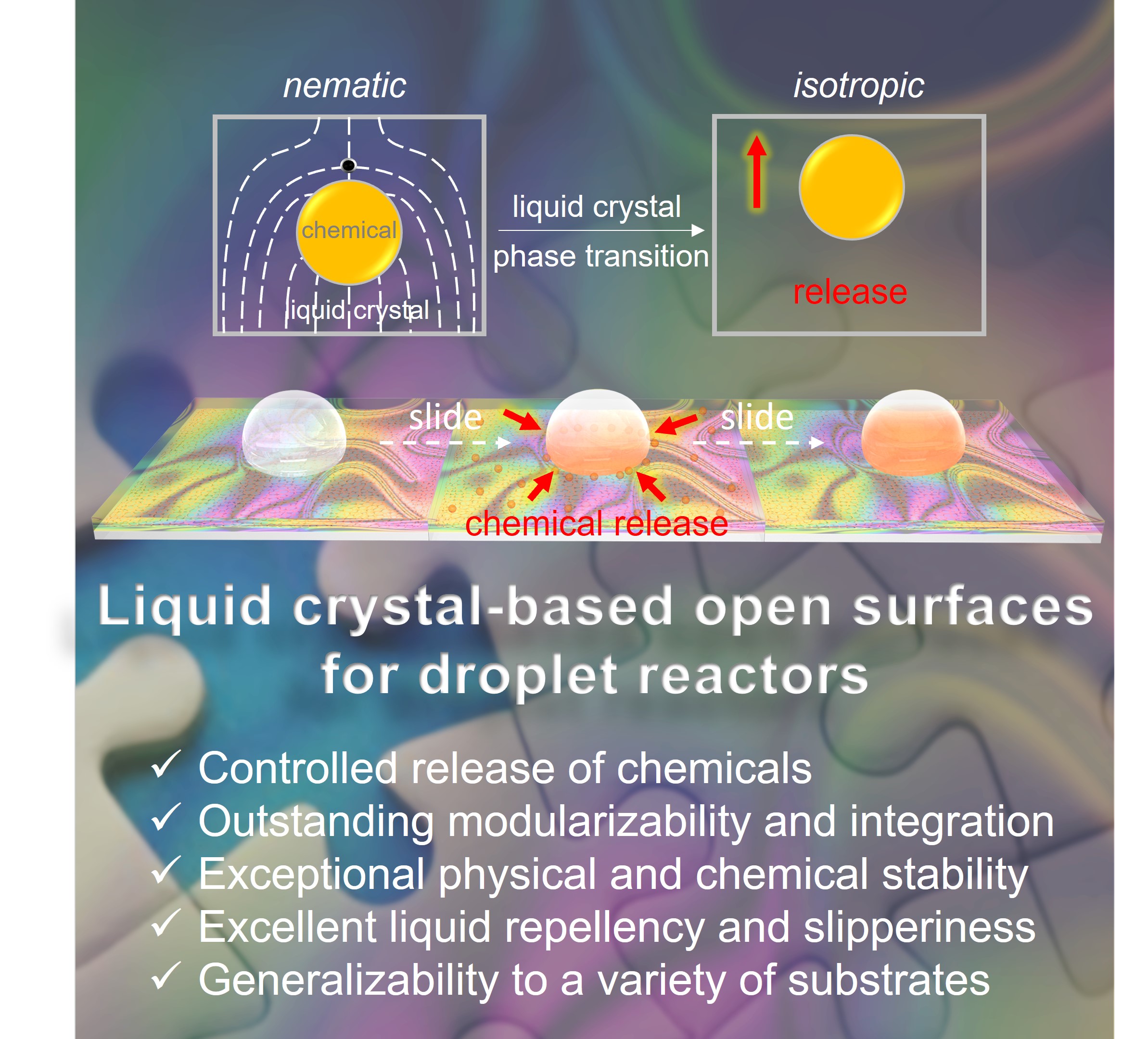The automated manipulation of the chemical composition and transport behaviors of liquid droplets is critical for the design of miniature droplet carriers and reactors for a wide range of applications, including water harvesting and transport, biomedical diagnostics, drug delivery, and smart droplet reactors. Two platforms, in-channel microfluidics and open surfaces, have recently been developed to create droplet carriers and reactors that can carry out chemical and biological processes inside a liquid droplet (usually water) with a volume on the order of microliters. In-channel microfluidic platforms require a delicate channel architecture to precisely modulate the droplet composition through either the fusion of droplets with different compositions or the direct injection of chemicals into the continuous stream, which significantly increases the complexity and cost of microfluidic device fabrication and operation. While superhydrophobic surface- and slippery liquid-infused porous surface (SLIPS)-based open surfaces have been shown to manipulate droplet movement using a variety of stimuli, these surfaces are unable to encapsulate and release chemicals in a controlled and automatic manner â their current dependence on the manual addition of chemicals to the droplet hinders their practical applications. Although other surface systems including layer-by-layer assembly, functionalized silica nanofractals, ferrofluid-infused anodic aluminum oxide, and liquid gating magnetoelastic porous membranes have been shown to enable control over cell and chemical release, the mobility of the water droplet on these surfaces and the potential use of them as platforms for droplet reactors and carriers have not been investigated yet. Therefore, the design of an easily fabricated and automatically operated surface device that enables a programmable feeding of chemicals to liquid droplets with outstanding mobility remains a substantial challenge.
Thermotropic liquid crystals (LCs), a particularly promising class of anisotropic liquids, exhibit a remarkably diverse group of colloidal and interfacial phenomena with unprecedented complexities and functionalities. For instance, LC films immersed in water have shown the ability to optically respond to chemicals or external fields and release cargo following an LC phase transition. These previous findings lead us to hypothesize that the intrinsic stimuli-responsiveness of LCs enables the design of a novel class of functional surfaces, which combine the programmable chemical feeding of microfluidics systems and the easy fabrication of open surface platforms that allow for the programmable feeding of chemical reagents to droplets. Very recently, we reported the design of a porous LC polymeric network to stabilize LC films against water droplet-induced dewetting, enabling chemical feeding to droplets on an LC surface platform. However, the integration of these LC surfaces to achieve the programmable and automatic release of multiple chemicals to manipulate (bio)chemical reactions in droplets without droplet pinning, a prerequisite for the design of advanced open surface droplet reactors, has not yet been achieved.
In this work, we designed and implemented an LC-based open surface platform that can encapsulate chemical reagents for future release into a liquid droplet on the surface via an LC phase transition. When combined with their natural water repellency and self-healing properties, our LC-based open surface platforms proved to be modularizable â where LC surfaces loaded with different chemical reagents can be freely assembled to program the order and quantity of chemical reagents released into the droplet on the surface â which enables a variety of sequential and parallel reactions and material synthesis including crystallization and (co)polymerization within water droplets. Additionally, we developed an LC surface-based device that is simple to operate and uses droplets as carriers to automatically control the feeding of cell signaling modulators for the simultaneous differentiation of human induced pluripotent stem cells (hiPSCs) into different cell types, e.g., endothelial progenitor cells and cardiomyocytes. Overall, the advances reported in this work provide design principles for novel, LC-based open surfaces for droplet carriers and reactors, offering an opportunity to achieve unprecedented levels of controllability, responsiveness, and automation for use in materials synthesis and regenerative cell therapy.


